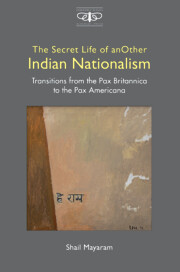 The Secret Life of Another Indian Nationalism
The Secret Life of Another Indian Nationalism Book contents
- Frontmatter
- Dedication
- Contents
- List of Figures
- List of Abbreviations
- Preface
- Acknowledgements
- Note on Transliteration
- 1 Introduction: Colonialism, Orientalism, Nationalism and the Shaping of Popular History and Religion
- 2 Orienting the Vernacular Imaginaire: James Tod and Indian Nationalism
- 3 War and Violence in Savarkar’s View of Indian History
- 4 Nationalism and Time: The Vishva Hindu Parishad’s Fantasmagorical History
- 5 Transforming Hinduism: The Politics of Vishva Hindu Parishad Conversion
- 6 AnOther History of Religion
- 7 Sushila Rawat, the Healer of Husain Tekri: Myth and Medical Pluralism as Resistance to Hindutva
- Index
Preface
Published online by Cambridge University Press: 11 February 2022
- Frontmatter
- Dedication
- Contents
- List of Figures
- List of Abbreviations
- Preface
- Acknowledgements
- Note on Transliteration
- 1 Introduction: Colonialism, Orientalism, Nationalism and the Shaping of Popular History and Religion
- 2 Orienting the Vernacular Imaginaire: James Tod and Indian Nationalism
- 3 War and Violence in Savarkar’s View of Indian History
- 4 Nationalism and Time: The Vishva Hindu Parishad’s Fantasmagorical History
- 5 Transforming Hinduism: The Politics of Vishva Hindu Parishad Conversion
- 6 AnOther History of Religion
- 7 Sushila Rawat, the Healer of Husain Tekri: Myth and Medical Pluralism as Resistance to Hindutva
- Index
Summary
This is a book about the making of the modern ultra-nationalist Hindu self. The emergence of ultra-nationalism did not just suddenly come about in the 1980s, leading to the Bharatiya Janata Party's consolidation of one-party dominance replacing what used to be the Congress system and, in addition, creating a unipolar ideological universe. Scholars such as John Zavos have tracked the origins of Hindu nationalism to the 1920s. Many identify it with the publication of Savarkar's Essentials of Hindutva in 1923. Ashis Nandy sees its beginning in Tagore's novel Gora (1907). I argue that the publication of Colonel James Tod's Annals and Antiquities of Rajast’han in 1829–32 had an electrifying effect on vernacular nationalism. In its aftermath the fields of literature and history both became sites of national devotion.
The process has had a long gestation over a couple of centuries. The temporal frame examined in this book is 1812 to 2014, from Tod's Report on the Pindaris to what has been called New Hindutva and its coming to power with the election of Narendra Modi. In no case has there been a unilinear trajectory; indeed, there have been many setbacks as from Champaran through Chauri Chaura and the early 1940s when a more multicultural nationalism held sway. Surely the politics leading to Partition and its aftermath again demonstrated the strength of hyper-nationalism reacting to the Muslim League's demand for greater representation.
On colonialism my intervention relates to two arguments posed in the public debate on the topic: that it was a different form of imperialism grounded, first, in the idea of race and, second, in the modern idea of religion that could be used to bolster sovereignty through divide and rule. Colonial modernity produced new organisational forms that mobilised Hindus, Muslims and others. The British Empire played a diabolical role resorting to partition in four troubled regions, Ireland, India, Palestine and Cyprus and fostered identity politics. The deeper problem was the colonisation of the Indian mind. Two ideas, in particular, played havoc in the subcontinent. The idea of History and of Religion, both in the upper case.
- Type
- Chapter
- Information
- The Secret Life of Another Indian NationalismTransitions from the Pax Britannica to the Pax Americana, pp. xiii - xviPublisher: Cambridge University PressPrint publication year: 2022
